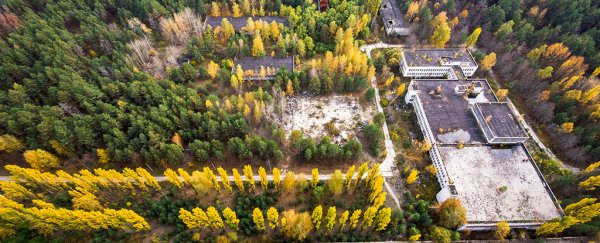Shortly after midnight on 26 April 1986, the name Chernobyl became synonymous with nuclear disaster. A nuclear power station in northern Ukraine exploded after a safety test, casting a radioactive shadow over the land.
The literal and figurative fallout of the event continues to inspire a strange mix of fear and hope over the risks of nuclear power. But it's still hard to know whether the field trial of an apocalypse was ultimately a win or a catastrophe for nature.
A 2,600 square kilometre (1,000 square mile) exclusion zone has accidentally become a sort of nature reserve. Census data shows some populations have boomed without humans around.
But years of studies on the zone's ecosystems also suggest much of the life hit hard by ionising radiation hasn't adapted. There are exceptions, opening debate on the future effects of fallout on organisms in areas like Chernobyl and Fukushima.
This is what we know so far.
Many microbes are quick to take advantage of disasters that spell doom for most other organisms.
Melanin-rich fungi such as Cladosporium sphaerospermum, Cryptococcus neoformans, and Wangiella dermatitidis have become kings of Chernobyl's inner sanctum thanks to the effects ionising radiation has on their pigments. Research shows not only have these fungi tolerated the power station's radioactivity – they've feasted on it.
It's not all good news for other decomposers in the surrounding ecosystems, though. While some of the smallest species have taken advantage, others have suffered greatly.
A study published in 2014 found a significant drop in the rate of decomposition of leaf litter at 20 forest sites around Chernobyl, pointing to big changes inside the exclusion zone for its tiniest recyclers.
Nuclear disasters are often imagined as barren wastelands of dust, dry grass, and stripped trees. If anything, images of Chernobyl's surrounds show it to be overgrown with foliage. What gives?
Well, not all of the plants did so well in Chernobyl's wake. Around 10 square kilometres (about 4 square miles) of pine woodland was dubbed the Red Forest after radiation damage turned their leaves brown. Many of the trees were bulldozed and the ground beneath remains one of the most contaminated parts of the exclusion zone.
But plants in other areas have found clever ways to cope with the stress of increased radiation.
A study on soybeans growing within Chernobyl's restricted zone was compared with plants grown 100 kilometres (over 60 miles) away.
The researchers found the radiated plants weren't exactly thriving, but managed to survive nonetheless by pumping out proteins known to bind heavy metals and reduce chromosomal abnormalities in humans.
Bird populations were some of the hardest hit by the disaster. One study on 550 specimens covering nearly 50 species found radiation impacted on the bird's neurological development, with a significant drop in brain volume.
While many bird populations dwindled in the aftermath, not all birds suffered equally. Females died in greater numbers than males, for example.
Having brighter feathers also put some species at a clear disadvantage.
The biochemistry used to produce large amounts of pheomelanin also depletes the body's supply of antioxidants – a useful family of chemicals to have in large amounts if you want to deal with the damage caused by radiation.
Researchers found population declines were stronger in those species had carotenoid colouration and large body masses, suggesting black has become the new orange in Chernobyl bird fashion.
Multitudes of mice and beasts bouncing back
Arguably, the most surprising discovery in Chernobyl's human-free-zone is the mass of mammals that made a quick return to the forests.
Studies conducted in the mid-1990s on the smaller critters, such as mice and voles, found there wasn't a noticeable difference in population sizes across the zone's boundary.
Larger animals, including deer and boar, have also bounced back in recent decades.
The biggest winners seem to be wolves, which have had a field day with large numbers of prey and scarcity of humans. By some estimates there are seven times more wolves inside the zone than outside.
Big numbers doesn't necessarily mean great health, though.
In the words of University of Portsmouth researcher Jim Smith, "This doesn't mean radiation is good for wildlife, just that the effects of human habitation, including hunting, farming, and forestry, are a lot worse."
For the most part, humans aren't allowed to live inside the exclusion zone. Around 350,000 people were evacuated, leaving the land for nature to reclaim.
Some 1,000 people returned to call the radiated land home in the ensuing months, choosing familiarity and solitude in spite of ticking Geiger counters.
Made up mostly of elderly women, these so-called "Babushkas of Chernobyl" are a vanishing people. Today barely one in ten of those returned citizens remain, though the dwindling numbers don't seem to be a direct consequence of their toxic surroundings, but rather succumbing to old age.
As with most living things in Chernobyl's ecosystem, it's hard to draw a line between the risks posed by radiation and thriving in a home abandoned by the modern world.
